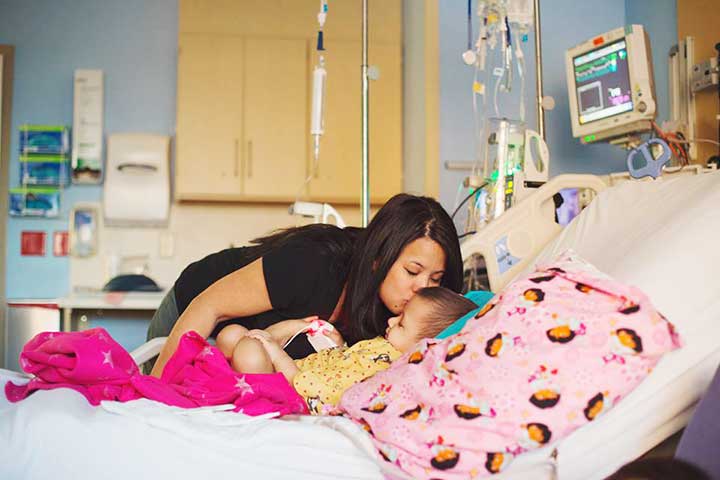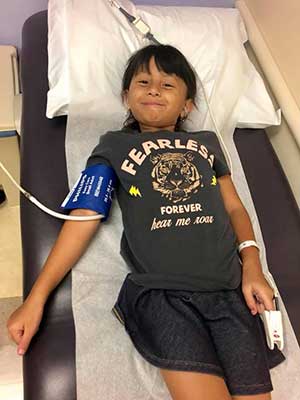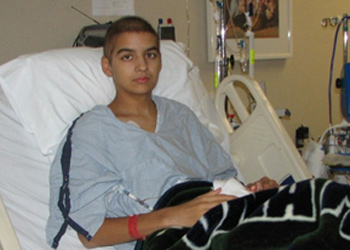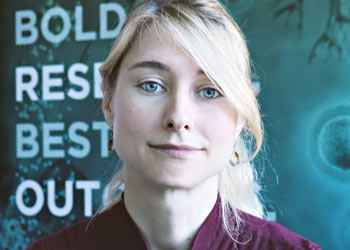By Rochelle Paterson
Rochelle Paterson is a mother of a childhood cancer survivor, a cancer research advocate and CureSearch supporter.
Our daughter, Rea, was a seemingly healthy and normal toddler until one day, when she began to limp. After a few weeks of medical testing, her doctors found a tennis ball-sized tumor on her left adrenal gland that was wrapped around her aorta. Her full diagnosis was Stage IV High Risk N-MYC Amplified Neuroblastoma with Unfavorable Histology.
At the age of two, Rea had metastatic cancer.
We were devastated and terrified. We didn’t know what to expect and were concerned about how Rea would handle and respond to treatment being so young.

Pediatric cancer families learn the hard way how underfunded childhood cancer is, how many different types of cancer need cures, and how limited our options often are.We need drugs that are personalized, less harsh and more effective to be available to all children battling cancer, so that survival rates increase with little to no long-term side effects.
All we could do was listen to the oncologists, follow Rea’s lead and pray that her treatment plan would work.
Many treatments and a clinical trial
Her protocol consisted of six rounds of high-dose chemotherapy, an autologous stem cell transplant, surgical resection of the primary tumor in her belly and left adrenal gland, 12 doses of radiation, seven months of immunotherapy, and another two years on a drug trial for remission maintenance. Rea was treated at Johns Hopkins All Children’s Hospital (JHACH) in St. Petersburg, FL, and we are grateful that she was able to join a clinical trial there.
Rea and the rest of us stayed as positive as possible

Thankfully, she responded miraculously well to treatment. She was 2 years old when she was diagnosed and 3-and-a-half when she finished inpatient treatment. She was nearly 6 years old when she completed the clinical trial. Now a happy and active 7-year-old, she has had no evidence of disease for five years! We’re so grateful for Rea’s health, but she does have special needs as a result of the toxic treatments. She has ongoing checkups and medical care with oncology, physical therapy, audiology and other specialty clinics. Treatment left her with one adrenal gland, hearing aids due to high frequency hearing loss, dental issues and chronic pain. For her and all kids that have gone through chemotherapy, radiation, etc., the reality is that even with the gift of survivorship, our children deserve so much better.
Our cancer journey taught us so much.

The main things we took away from our battle with cancer were: to have faith, live your best life, make lots of memories with your loved ones, and try not to sweat the small stuff. We also learned how underfunded childhood cancer is, so we encourage research funding and awareness as much as possible. That is why our family and friends support CureSearch and actively fundraise for the CureSearch Walk in Tampa. We push for support because we want drugs that are personalized, less harsh and more effective to be available to all children battling cancer, so that survival rates can increase with little-to-no long-term side effects.
Have faith and never give up hope.
Rea’s irrepressible personality has been so consistent. During her inpatient days, she would dance through admissions and the nurses joined in.
—–
Each year, nearly 700 children like Rea are diagnosed with neuroblastoma in the U.S. Current treatments offer a survival rate of only 50% and have significant, long-term effects, including increased risk of developing deafness, cardiac insufficiency, infertility and additional cancers. CureSearch for Children’s Cancer is funding two neuroblastoma research projects right now at the University of Pennsylvania and Dana Farber Cancer Institute to develop less-toxic treatments and cures. Will you give the gift of research for kids like Rea? Every child deserves a chance to live a long, healthy life.
Want more stories like this?
Get emails that matter, when it matters.



